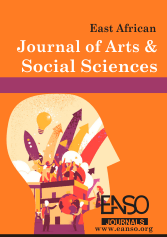Linguistic Accommodation and Identity in The Context of Social Media Discourse
Abstract
Peaceful coexistence among members of the society is paramount. However, conflicts among the people living together are inevitable and therefore conflict resolution mechanisms must always be put in place. This paper focuses on how language can be used as a tool for resolving and maintaining peace among the individuals in the context of social media. Our society is organised in such a manner that people interact at various levels in the community and there are different forums and platforms that individuals use in the interaction process. During their interactions, language plays a very important role in ensuring that people live in harmony. Living harmoniously may be a concern for people that work together, live in the same neighbourhood, go to church together or live together. These people may interact on face-to-face basis and or use other media such as social media to reach out to one another. This paper narrows down to the kind of interactions that take place in the social media and how the interactants accommodate or cope with each other. The paper analyses texts extracted from Chuka University Students’ social media discourse (from the author’s PhD thesis) to reveal how students accommodate one another. This is an important aspect particularly nowadays when people have made social media an integral tool of communication and interaction. There are different platforms and genres of social media interaction platforms such as Facebook, twitter, Instagram and WhatsApp just to mention a few but this paper focuses on WhatsApp. The WhatsApp groups from which data for analysis were extracted, were those formed by Chuka University students in Tharaka Nithi County, Kenya. This paper is informed by Communication Accommodation Theory and Social Identity Theory. Since it was a qualitative investigation, a descriptive research design was used. Snowballing was used in the identification of the WhatsApp groups from which the texts were extracted purposively. The texts used in this paper were purposively collected on the basis of their content to show accommodation and identity among the social media users. The content analysis of the texts was done and results discussed. The findings revealed that students accommodate one another in their interactions and that they use language to mark their identity. The accommodation is achieved by using language in a manner that is peculiar to them. They for instance come up with their own jargons, phrases and forms of words that they use in their communication
Downloads
References
Bunz,U & Campbell,S.W. (2004). Politeness Accommodation in Electronic Mail. Communication Research Reports. 21 (1) 11-25
Crystal, D. (2001). Language and the internet. Cambridge: Cambridge University Press.
Giles, H. (1977). Language, ethnicity and intergroup relations. New York: Academic Press
Giles, H., Coupland, J., & Coupland. N. (Eds.) (1991). The contexts of accommodation: Developments in applied sociolinguistics. New York: Cambridge University Press.
Giles, H., Coupland, N. & Coupland, J. (1991). Accommodation theory: Communication, context. In H. Giles, N. Coupland & J. Coupland (Eds.), Contexts of accommodation (pp. 1-68). Cambridge: Cambridge University Press.
Giles, H. & Ogay, T. (2006). Communication accommodation Theory. In B.B Whaley and W. Samster (Eds), explaining communication: contemporary theories and exemplars (293-310). Mahwah, NJ:Er Ibaum
Hilte, L Vandekerckhovc ,R and Daelemans, W. (2020). Linguistic Accommodation in Teenagers’ Social Media Writing: Convergence Patterns Mixed Gender Conversations, Journal of Quantitative Linguistics 29 (2) 241-268
Perez-Sabater, C. (2017). Linguistic accommodation in online communication: the role of language and gender. Revista Signos 50 (94). 265-286
Tajfel, H. (1981). Human groups and social categories. Cambridge: Cambridge University Press
Thomson, R., Murachver, T.,Green, J.,(2001). Where is gender in gendered language; Psychological Science,12, 171-175
Copyright (c) 2024 Miriti Gervasio, PhD

This work is licensed under a Creative Commons Attribution 4.0 International License.




























